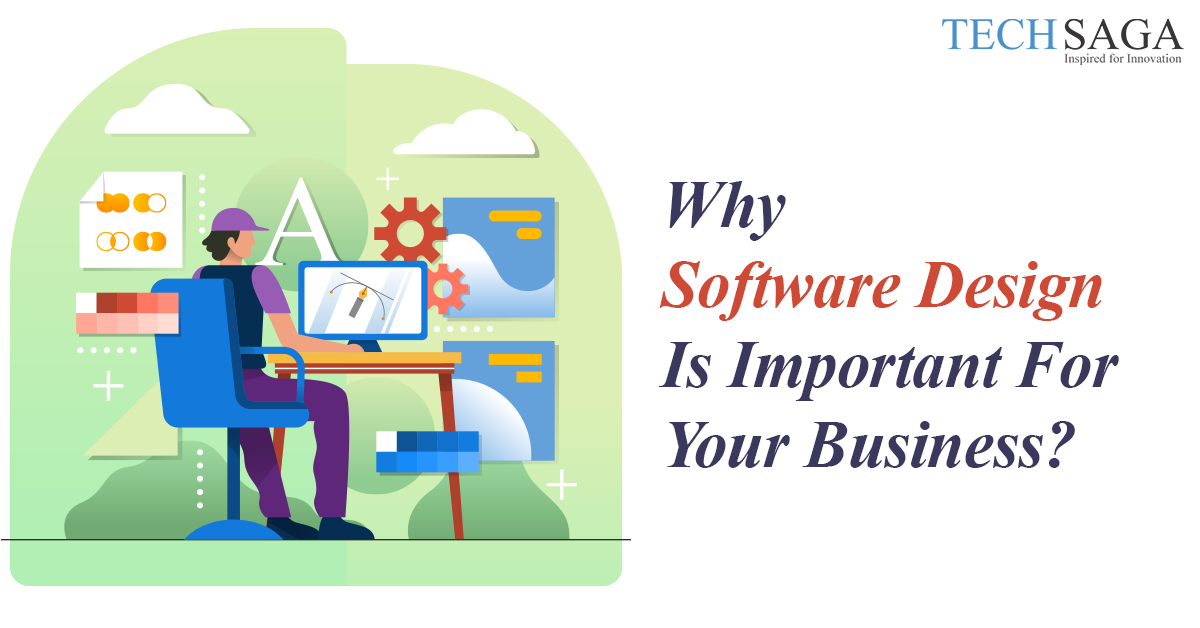Team Techsaga
Gain valuable insights and stay updated with the latest innovations through our engaging blog. Explore trends, technology advancements, and expert opinions to navigate the ever-evolving world of IT.
Why Software Design Is Important For Your Business?
When a software engineer starts working on a new project, it’s normal for him to start scripting the code right away. Regardless of his software competence, if someone creates software without first developing a plan for it, he is putting bricks without first laying a stable foundation. Therefore, the structure will collapse regardless of how strong the construction process and resource usage are; similarly, the program will fail in the absence of a core plan. Nobody wants their efforts to go to waste because they didn’t prepare ahead of time, do they? That’s where a Software Development Company in Noida comes in, as a tool that streamlines critical software functions.
What is Software Design?
Software design is the process of producing a blueprint, or layout, for organizing the code of a software program. It’s that simple to describe, but is it that simple to carry out? That is an entirely different instance, however, if you are conducting software design for a new software project, you must comprehend its relevance; otherwise, you may neglect its sharpness.
Software development is a multi-step process. The program is a multi-layer, multi-dimensional spectrum with several intermediary procedures in its production.
Two primary stages separate the design of software:
- Conceptual Design
- Technical Design
Conceptual Design-
You might find assembling software components in a non-technical manner intriguing, especially when it’s part of the concept generation process. For example, you could want to create a list of all the components and their functions, as well as wireframes and flow diagrams. As a result, in conceptual design, we focus on non-technical representations of software.
The following are examples of common conceptual design methods:
- Wireframes
- Mockups with a flow chart
- Diagrams of component parts
- Cards for Class-Responsibility-Collaboration (CRC)
Technical Design-
After you’ve completed the conceptual design, you may begin to consider the technical specifics. You could now want to ask yourself things like,
- How would it be put into action?
- What will its relationship be with the Server/Database?
- What effect will it have on other modules?
The technical design process addresses all these challenges, with the majority of its focus directed toward outlining how the implementation will be executed. Examples of common technical design methodologies include:
- Diagrams of Classes
- Activity flowchart
- Diagram of the sequence of events
- Diagram of States
Architectural Views-
To describe software architecture, many architectural views are typically employed. Each architectural approach addresses consumers, designers, managers, system engineers, programmers, and other stakeholders in the software development process.
The views illustrate how the software architecture is divided into modules and interconnected modules, encapsulating the key structural software design decisions. Of course, these software design decisions must be based on requirements, functional and non-functional limitations, and other constraints. These decisions, however, place further constraints on demand and future software design alternatives at a lower level.
Objectives of Software Design:
The following are the objectives of software design:
1. Correctness-
A good design should appropriately implement all of the system’s features.
2. Efficiency-
All resource, cost, and time optimization challenges are addressed by good software.
3. Understandability-
An excellent design is simple to grasp. It should be modular, with all components organized in tiers.
4. Completeness-
The design should include all components such as data structures, modules, external interfaces, and so on.
5. Maintainability-
When a modification request is submitted by a client, a good software design should be easily adaptable.
Principles of Good Software Design:

Applying the following concepts to software design makes it one of the most user-friendly and convenient designs.
1. Modularity-
Modularity refers to the division of a large software project into smaller portions/modules. It is essential for creating technically sound and maintainable software. The project is divided into sections. Each was worked on independently. Testing each module becomes easier as a result of the modularity.
2. Coupling-
Low coupling is an important feature of effective design. Because of the low coupling, each module may be modified independently of the others.
3. Abstraction-
Abstraction is the process of identifying the essential behavior by isolating it from its implementation and removing superfluous parts. Separating crucial behavior from its implementation will result in unwanted coupling.
4. Anticipation of Change-
Software requirements are always changing as a result of changing needs. The capacity to adapt and adjust to change in a pleasant manner is essential in developing a great software design.
5. Simplicity-
The objective of effective software design is to keep things as simple as possible. Each work contains an individual module that may be utilized and customized. It improves the code’s readability and reduces the frequency of mistakes.
6. Sufficiency and Completeness-
An excellent Software Design Company ensures that the program meets the criteria in an adequate and complete manner. It verifies that the program was built correctly and entirely.
Types of software level design:
There are three different levels of software design, including:
Architectural Design-
A system’s architecture may be described as the overall structure of the system and the mechanism by which that structure preserves the conceptual integrity of the system. The program is recognized as a system with several interrelated components by the architectural design. At this stage, the designers have an overview of the potential solution domain.
Preliminary or high-level Design-
The problem is divided into a number of modules, with the control linkages and interfaces between them identified. This stage yields the program architecture. At this level, two design representation techniques are used: structure charts and UML.
Detailed Design-
When the high-level design is done, a full design is carried out. Each module is thoroughly researched in order to create a precise architecture of the data structure and algorithms. The completion of the stage is documented in a module specification document.
Why is software design so important?
Design is the fundamental building block for software development. It maintains the flow:
Better-designed software is more adaptive. As a consequence, you may add a new component to the existing program without interfering with it.
Well-designed software increases reusability. Adhering to design patterns will make your program more modular, consisting of distinct components that each serve a particular goal. As a result, these little components may easily be reused.
Simple to Understand-
It has always been difficult to explain projects to new hires/team members. However, if your design and documentation are solid, you will be able to easily communicate the concept of the product to your new team members.
Increased cost efficiency-
You may be wondering how design affects the cost of software. Next, consider the following scenario: You and your team begin designing software based on certain assumptions. Even yet, after finishing half of it, you realize you’ve hit a snag and can no longer proceed with those assumptions. You must now reinstall the program, which will be rather costly.
What Are the Proper Methods of Software Design?
Here are some considerations for carrying out the design properly:
In fact, prototypes are used to reduce risk and uncertainty regarding the profitability of the product under development, as well as the stability of crucial technological performance.
Participation in or financing of the project Knowledge of the requirements
The product’s look, function, and usefulness-
A prototype may assist in creating product support by demonstrating users, buyers, and management something real and achievable.
The nature and function of the prototype, on the other hand, must be obvious at all times. In general, even if a prototype works, it should not be used in the final product.
An exploratory, behavioral prototype, for example, designed to swiftly test the user interface is seldom transformed into a stable, long-lasting product.
Architectural Analysis-
The architectural analysis’s purpose is to identify a projected architecture and constrain the architectural techniques that may be used in the system. In fact, the focus here is on gathering insights from comparable systems or problem domains, ensuring that we don’t spend unnecessary time “reinventing the wheel.” In cases where the architecture is well-established, this step can be omitted. Architectural analysis is very important for developing new and creative solutions.
System Behavior Analysis-
This step converts the behavioral descriptions provided by the use cases created during the requirements-gathering stage into a collection of system-building pieces.
Important questions to ask:
When it comes to development, it is not simply about creating software. In fact, you must change them on a regular basis in order to keep them in pristine condition for an extended period of time. So, please take a moment to ponder and attempt to answer the following questions.
- How simple was it to modify your code?
- Did a minor code change cause rippling effects in other parts of the code?
- Was it difficult to reuse your code?
- Was it tough to maintain the program once it was released?
- Did they come up with a nice design? Could the design be improved?
- Is there a design at all?
- It’s not only about good design code. It all comes down to communicating your software concepts with other engineers, teams, and clients.
Read Also:- Leveraging AI for Enhanced Software Development
Helpful Tools for Software Design:
Here are some of the top software design tools.
1. Draw.io-
Confluence and Jira users may use Draw.io to draw diagrams. Flowcharts, process diagrams, ER diagrams, and much more may be easily constructed. Moreover, it also aids in the development of your form library.
2. Jira-
Jira is a robust software development platform that lets you plan, manage, release, and report on your projects. In fact, it also lets you choose from a variety of processes or construct your own. It’s simple to integrate with the tools you already have.
3. Mockflow-
Mockflow is a web-based wireframe tool that helps designers plan, build, and share their concepts. Furthermore, which is cloud-based, provides users with access to an extensive library of mock components, icons, stickers, and more.
4. Figma-
In fact, a vector graphics editor and prototyping tool that is accessible over the web. Also, it’s touted as the most revolutionary graphics editing tool available in the market today. Users of Figma may wireframe websites, build mobile app interfaces, prototype designs, and create social media posts.
5. Marvel-
Marvel provides simple design and prototyping tools to help software developers wireframe, create, and prototype rapidly.
6. Zeplin-
It provides a space for designers to exchange, organize, and collaborate on their work. Zeplin makes it easier for designers and engineers to collaborate.
Summary:
In a Nutshell, the Software Design Process is the most crucial phase in producing effective software. Since, it is the first and most critical stage. It’s a user-friendly technique. It ranks the user’s needs, requirements, and restrictions. It is critical for attracting customers and sustaining their allegiance to the product.
If you want the assistance of an experienced software development team, please contact Best Software Development Company in Noida-Techsaga. By employing a variety of tools and adhering strictly to the various phases of the software design process, one may produce better, more efficient, and user-friendly software designs.
TAG: Software Development




